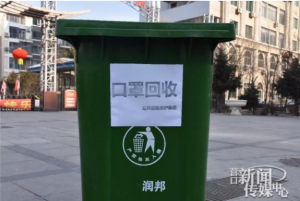China’s Medical Waste Disposal Market Situation During the COVID-19 Outbreak
Since the outbreak of SARS in 2003, China has recognized the importance of proper medical waste disposal and management. In 2003, the Chinese State Council approved the implementation of the National Hazardous Waste and Medical Waste Disposal Facility Construction Plan, and determined that prefecture-level cities should establish and operate centralized medical waste disposal facilities. According to the “Chinese National Annual Report on Solid Waste Pollution Prevention and Control in Large and Medium-sized Cities in 2019”, the amount of medical waste generated in 200 large and medium-sized cities in 2018 was 817,000 tons and the amount that underwent treatment and disposal was 816,000 tons in the same year.
However, ever since the COVID-19 broke out in China, the disposal capability of medical waste facilities has been confronted with a huge challenge. During the outbreak, an extremely large number of disposable masks, protective clothing and other medical supplies have been quickly consumed in the medical institutions. At the same time, even people who are not infected have been recommended and required to wear masks to ensure no cross-infection occurs, as COVID-19 has incubation period, therefore generating a large amount of waste masks. If the medical wastes from hospital and communities are not treated and disposed properly, secondary infections may occur.
 Figure 1. Wuhan Tongji Hospital has had a sharp increase in medical waste after the epidemic (Source from The Paper.CN)
Figure 1. Wuhan Tongji Hospital has had a sharp increase in medical waste after the epidemic (Source from The Paper.CN)
The Status of Medical Waste Disposal in China during the COVID-19 outbreak
The Disposal Status in Hubei Province (Especially in Wuhan)
Hubei, as the region with the most severe outbreak, had a total of 65,914 confirmed cases as of February 27. Medical institutions such as hospitals and cabin medical institutions, which are used as centralized isolation suites for patients with mild symptoms, have generated a large amount of medical waste. Before the epidemic outbreak, 11 out of 13 prefecture-level cities (excluding Suizhou and Yichang which each had 2 hazardous waste treatment centers) each had their own enterprise involved in the centralized collection and disposal of medical waste. The medical waste disposal capacity in Hubei Province was about 180 tons per day, and the incineration disposal capacity of medical waste in Wuhan was 50 tons per day. However, after the outbreak of COVID-19, all prefecture-level cities in Hubei have had insufficient treatment and disposal capacity. Moreover, the capability problems in Wuhan, Xiaogan, Huanggang, and Jingzhou are prominent. Since January 26, the amount of medical waste collected in Xiaogan City has increased from its usual 3 tons / day to 13 tons / day, the amount in Huanggang increased from 3.6 tons / day to 15 tons / day, and the amount in Wuhan significantly increased from 45 tons / day to more than 100 tons / day.
Take Wuhan, the most serious epidemic area, as an example. After the outbreak, as the amount of medical waste increased, the incineration facilities of Wuhan Beihu Yunfeng Environmental Protection Technology Co., Ltd. were rebuilt to treat and dispose of medical waste. Since January 30, Hubei Zhongyou Youyi Environmental Protection Technology Co., Ltd. has collected some of the medical waste in Wuhan and transported it to the city of Xiangyang for off-site disposal. The Fire-God Mountain Hospital and Thunder-God Mountain Hospital, infectious disease specialist hospitals built after the outbreak in 7 days, have ancillary in-situ disposal facilities and the facilities have been put into operation in early February. During this period, Wuhan municipal solid waste incineration plants have also disposed of more than 30 tons of medical waste. As of February 19, the actual disposal amount of medical waste in Wuhan has been around 110 tons per day.
 Figure 2. The in-situ medical waste incineration facility in Thunder-God Mountain Hospital (Source from The Paper.CN)
Figure 2. The in-situ medical waste incineration facility in Thunder-God Mountain Hospital (Source from The Paper.CN)
In addition, the China’s Ministry of Ecology and Environment allocated mobile disposal facilities to Wuhan and the China Energy Conservation and Environmental Protection Group urgently constructed a 30-ton-per-day high temperature steam treatment facility which is scheduled to be put into operation at the end of February. The incineration cabins, which are jointly built by the Nanjing Institute of Environmental Science of the Ministry of Ecology and Environment and China State Shipbuilding Corporation Nanjing Luzhou Machine Co.,Ltd, will also be installed on site and put into use in a few days. At the end of February, the city of Wuhan will have a treatment and disposal capacity of more than 170 tons per day.
Disposal Status of Other Provinces and Cities in China
As the epidemic situation in other provinces is not as serious as in Hubei, the environmental protection departments have focused more on the treatment and disposal of masks in communities and other population-intensive areas to prevent secondary infection. As different cities have their own waste disposal plan, EnvGuide has selected some provinces and cities near Hubei Province or with large population to serve as examples.
 Figure 3. Specialized medical waste transfer boxes in Manzhouli City (Source from Hulunbuir Daily
Figure 3. Specialized medical waste transfer boxes in Manzhouli City (Source from Hulunbuir Daily
Jiangxi Province, which is adjacent to Hubei Province, announced that the masks needed classified waste management. On the one hand, communities, airports, stations, squares, large shopping malls, and other population-intensive areas need to set up specific collection buckets for waste masks. On the other hand, specific waste buckets for contaminated masks are required for centralized isolation observation points and home isolation observation points. In addition, the sanitation department uses chlorine-containing disinfectants and has employed specialized personnel trained for daily cleaning and disinfection of waste containers, municipal waste transport vehicles, medical waste transfer vehicles, waste collection points, waste transfer stations, and etc.
After the outbreak, the city of Xiamen implemented its own the mask waste management plan. On February 5th, Xiamen set up 9,495 specialized waste cans for discarding masks to achieve full coverage in more than 2,800 communities. The Xiamen environmental sanitation department has also invested in more than 30 collection and transportation vehicles to ensure the daily clearance of the mask waste. At the same time, specialized factory disposal methods have been carried out on the waste masks to make sure they are incinerated in a separate furnace. The temperature in the furnaces are controlled to be above 1000 degrees Celsius which can completely kill the virus.
 Figure 4. Community specialized mask collection cans in City of Yingkou (Source from Yingkou News)
Figure 4. Community specialized mask collection cans in City of Yingkou (Source from Yingkou News)
At the same time, the Beijing Cement Plant Co., Ltd. has taken over the task of incineration and disposal of medical waste in Beijing. In the Jiangsu and Zhejiang provinces, the average daily treatment and disposal volume of medical waste at the Hazardous Waste Disposal Base of Dongjiang Environmental Company Limited increased by 30% to 40%. The cities of Shanwei, Dongying, Putian, Xiantao, and Zhuhai, have all used municipal waste incineration facilities for emergency treatment and disposal of medical waste during the epidemic. A total of 22 medical waste alternative disposal units have been selected in 16 cities in Shandong Province and if necessary, the province’s alternative medical waste disposal capacity can reach to 894.2 tons / day.
 Figure 5. Monitoring the body temperature of the staffs in specialized medical waste transfer truck in Beijing (Source from the Beijing News)
Figure 5. Monitoring the body temperature of the staffs in specialized medical waste transfer truck in Beijing (Source from the Beijing News)
Recommendations from China’s Medical Waste Disposal Practices during the COVID-19 Outbreak will have on China in the future
Sun Ning, the director of the Environmental Engineering Department of the Chinese Academy of Environmental Planning, analyzed the emergency treatment and disposal processes of medical waste in China and provided recommendations for medical waste management as follows:
(1) Attention should be paid to the completeness of the medical waste disposal system, especially the emergency disposal system. Disposal of medical waste in urban infrastructure construction systems is often not valued enough due to factors such as too small amounts of disposal, small numbers of facilities, and the relatively remote location. However, the proper treatment and disposal of infectious waste are extremely important when infectious diseases break out.
(2) At present, the technical level of emergency incineration facilities for medical waste is generally low. Local or nearby non-incineration disposal methods (high temperature steam sterilization method, microwave sterilization method, chemical sterilization method, etc.) are suggested to be adopted in emergency situations. After the non-incineration disposal of the medial wastes, transportation and centralized incineration of them should also be considered as a proper way, and the whole process could in this way meet safety, health and environmental protection requirements.
(3) The medical waste generated during an epidemic situation can be further subdivided into different types, which provides a prerequisite for the use of different technologies for classified disposal. Generally, it could be divided into the following types: (a) highly infectious medical waste, which is in direct contact with infected patients; (b) traditional medical waste, which is relative to highly infectious waste; (c) Waste mixed with highly infectious waste, such as municipal waste and bedding generated from isolation wards. This type of waste is usually considered municipal garbage during normal periods, but because they are in close contact with patients, they are also considered medical waste in epidemic situations. As for the disposal methods, the first type of waste above should be treated and disposed by incineration if possible. The second type of waste can be sterilized with non-incineration methods and then concentratedly disposed. The third type of waste can be incinerated centrally after disinfection by chemicals.
(4) On-site emergency disposal facilities, medical waste transfer boxes, medical waste transfer trucks, and full sets of protective equipment required for on-site operations shall be included in the list of local safety emergency protection facilities. When certain kinds of epidemics break out, the related local departments can use the list for reference, and know where and how to get the equipment.
(5) Establish national and regional medical waste emergency expert teams, management teams, and operation teams. Moreover, enterprise suppliers should be selected and identified under normal circumstances so that they can take quick action as soon as an emergency occurs.
The data and information in this article comes from XINHUA.NET, ChinaNews.com, the Ministry of Ecology and Environment, and the China Association of Environmental Protection Industry.
About EnvGuide
EnvGuide, an environmental information & e-commerce platform, was developed by the US-China Environmental Education Foundation (UCEEF), sponsored by the US Department of Commerce (USDOC) International Trade Administration (ITA) through its Market Development Cooperator Program (MDCP) and donations from readers like you.
The EnvGuide platform is a bridge between the United States and China so that environment-related organizations are able to share the industry’s latest environmental advice, technologies, and instrumentation/equipment application on the platform; US environmental products can be introduced to China. For more information please visit EnvGuide Website.






